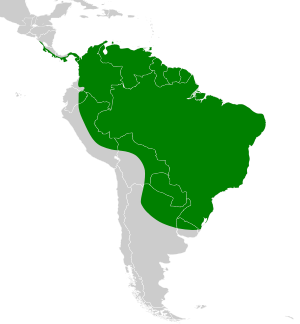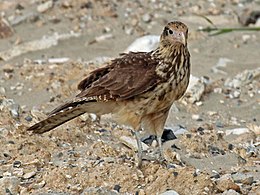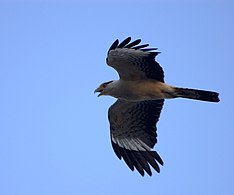Yellow-headed caracara
| Yellow-headed caracara | |
|---|---|

| |
| Adult at Serra da Canastra National Park, Brazil | |
| Scientific classification | |
| Kingdom: | Animalia |
| Phylum: | Chordata |
| Class: | Aves |
| Order: | Falconiformes |
| Family: | Falconidae |
| Genus: | Milvago |
| Species: | M. chimachima
|
| Binomial name | |
| Milvago chimachima Vieillot, 1816
| |

| |
| Synonyms | |
|
Polyborus chimachima (Vieillot, 1816) | |
The yellow-headed caracara (Daptrius chimachima) is a bird of prey in the family Falconidae. It is found in tropical and subtropical South America and the southern portion of Central America. Unlike the falcons in the same family, the caracara is not a fast-flying aerial hunter, but is rather sluggish and often obtains food by scavenging.
Taxonomy
When Louis Jean Pierre Vieillot first described the yellow-headed caracara in 1816, he gave it the scientific name Polyborus chimachima, putting it in the same genus as the crested caracaras.[2] In 1824, German naturalist Johann Baptist von Spix created the genus Milvago for this species and the closely related chimango caracara.[3]
Formerly, the yellow-headed caracara was classified in the genus Milvago together with the Chimango caracara (then Milvago chimango). However, molecular studies from 2012 showed that the genus Milvago is not monophyletic. These two species were therefore reclassified together with various other species in the genus Phalcoboenus with the species' closest relative (the Black caracara, Daptrius ater). These species are now all part of the genus Daptrius[4]. These changes have been adopted in the 2022 edition of the The Clements Checklist of Birds of the World.
Description
The yellow-headed caracara is 41–46 cm (16–18 in) in length and weighs 325 g (11.5 oz) on average. Like many other birds of prey,[5] the female is larger than the male, weighing 310–360 g (11–13 oz) against the male's 280–330 g (9.9–11.6 oz). Apart from the difference in size, there is no significant sexual dimorphism in this species. It is broad-winged and long-tailed, somewhat resembling a small Buteo. The adult has a buff head, with a black streak behind the eye, and buff underparts. The upper plumage is brown with distinctive pale patches on the flight feathers of the wings, and the tail is barred cream and brown. The head and underparts of immature birds have dense brown mottling.
The voice is a characteristic screamed schreee.
Distribution and habitat
This is a bird of savanna, swamps and forest edges. Resident from Costa Rica south through Trinidad and Tobago to northern Argentina (the provinces of Misiones, Chaco, Formosa, Corrientes and Santa Fe), it is typically found from sea level to 1,800 m (5,900 ft), and occasionally to 2,600 m (8,500 ft) above mean sea level. In southern South America, it is replaced by a close relative, the chimango caracara, whose range overlaps with that of the yellow-headed caracara in southern Brazil, northern Argentina, Paraguay and Uruguay. A larger and stouter paleosubspecies, Milvago chimachima readei, occurred in Florida and possibly elsewhere some tens of thousand years ago, during the Late Pleistocene.[6] According to the Peregrine Fund database, the yellow-headed caracara is expanding its range into Nicaragua.[7]
Behavior and ecology
The yellow-headed caracara is omnivorous, and will eat crabs, fish,[8] reptiles, amphibians, mammals[9] and other small animals, as well as carrion, dung and garbage.[8] Birds (such as nestlings and young chickens)[9][8] are rarely if ever taken, and this species will not elicit warning calls from mixed-species feeding flocks that cross its path even in open cerrado habitat.[10] It will also remove and eat ticks from cattle and Baird's tapir (Tapirus bairdii),[11] and is sometimes called the tickbird. It has been observed also to forage for small invertebrates in the fur of brown-throated three-toed sloths[12] and capybaras. They feed not only on adult insects but also on pupae and larvae of Lepidoptera, Diptera and Orthoptera.[9] In addition, at least younger birds are fond of certain fruits, such as those of the coconut palm (Cocos nucifera),[9] oil palm (Elaeis guineensis) and pequi (Caryocar brasiliense).[13] It lays from five to seven brown-marked buff eggs in a stick nest in a tree.[14]
The yellow-headed caracara has benefited from forest clearing for cattle ranching. Its status in Trinidad has changed from rare to fairly common, and it was first seen on Tobago in 1987.[15] It adapts readily to urban areas and, together with species such as the American black vulture (Coragyps atratus), it is among the most commonly seen bird of prey in Latin American cities. Consequently, this wide-ranging species has been assigned a risk level of Least Concern category on the IUCN Red List.[1] In Panama City for example, as a result of the increased urban sprawl, yellow-headed caracara pairs are frequently seen along the rooftops in suburban neighborhoods.
Gallery
References
- ^ a b BirdLife International (2020). "Milvago chimachima". IUCN Red List of Threatened Species. 2020: e.T22696261A163573161. doi:10.2305/IUCN.UK.2020-3.RLTS.T22696261A163573161.en. Retrieved 19 November 2021.
- ^ Drapiez, Auguste (1838). Dictionnaire classique des sciences naturelles, présentant la définition, l'analyse et l'histoire de tous les êtres qui composent les trois règnes (in French). Vol. 4. Brussels, Belgium: Meline et Cans. p. 350.
- ^ Godwin, Frederick Ducane; Salvin, Osbert (1904). Biologia centrali-americana. Vol. 3. R.H. Porter. p. 127.
- ^ FUCHS, JÉRÔME; JOHNSON, JEFF A.; MINDELL, DAVID P. (2012-03-05). "Molecular systematics of the caracaras and allies (Falconidae: Polyborinae) inferred from mitochondrial and nuclear sequence data". Ibis. Wiley. 154 (3): 520–532. doi:10.1111/j.1474-919x.2012.01222.x. ISSN 0019-1019.
- ^ Andersson, MB (1994). Sexual selection. Princeton, New Jersey: Princeton University Press. p. 269. ISBN 978-0-691-00057-2.
- ^ Emslie, S.D. (1998). "Avian Community, Climate, and Sea-Level Changes in the Plio-Pleistocene of the Florida Peninsula" (PDF). Ornithological Monographs. 50 (50): 44–45. doi:10.2307/40166707. JSTOR 40166707.
- ^ "Milvago chimachima". Global Raptor Information Network. The Peregrine Fund. Retrieved 2011-07-15.
- ^ a b c "Yellow-headed Caracara | the Peregrine Fund".
- ^ a b c d "Milvago chimachima (Yellow-headed Caracara)" (PDF). Sta.uwi.edu. Retrieved 10 April 2022.
- ^ Ragusa-Netto, J. (2000). "Raptors and "campo-cerrado" bird mixed flock led by Cypsnagra hirundinacea (Emberizidae: Thraupinae)" (PDF). Revista Brasileira de Biologia (in English and Portuguese). 60 (3): 461–467. doi:10.1590/S0034-71082000000300011. PMID 11188872. Retrieved 2011-07-15.
- ^ Coulson JO, Rondeau E, Caravaca M (March 2018). "Yellow-headed Caracara and Black Vulture Cleaning Baird's Tapir". Journal of Raptor Research. 52 (1): 104–107. doi:10.3356/JRR-16-90.1. S2CID 91157180.
- ^ Krakauer, A.H.; Krakauer, T.H. (1999). "Foraging of Yellow-headed Caracaras in the Fur of a Three-toed Sloth" (PDF). Journal of Raptor Research. 33 (3): 270.
- ^ Olmos, Fábio; Pacheco, José Fernando; Silveira, Luís Fábio (2006). "Notas sobre aves de rapina (Cathartidae, Acciptridae e Falconidae) brasileiras" [Notes on Brazilian birds of prey] (PDF). Revista Brasileira de Ornitologia (in Portuguese and English). 14 (4): 401–404. Archived from the original (PDF) on 2008-12-17. Retrieved 2008-11-19.
- ^ Pereira, José Felipe Monteiro (2008). Aves e Pássaros Comuns do Rio de Janeiro [Common birds of Rio de Janeiro]. Rio de Janeiro: Technical Books. p. 45. ISBN 978-85-61368-00-5.
- ^ ffrench, Richard; O'Neill, John Patton; Eckelberry, Don R. (1991). A Guide to the Birds of Trinidad and Tobago (2nd ed.). Ithaca, N.Y.: Comstock Publishing. ISBN 0-8014-9792-2.
Further reading
- Hilty, Steven L. (2003). Birds of Venezuela. Princeton University Press. ISBN 0-7136-6418-5.
External links
- "Yellow-headed caracara media". Internet Bird Collection.
- Yellow-headed caracara photo gallery at VIREO (Drexel University)
- Yellow-headed caracara Photo at panama-guide.com
- Yellow-headed caracara species account at Neotropical Birds (Cornell Lab of Ornithology)
- Interactive range map of Milvago chimachima at IUCN Red List mapsError: "Q28484" is not a valid Wikidata entity ID.
- CS1 French-language sources (fr)
- CS1 Portuguese-language sources (pt)
- Articles with short description
- Short description with empty Wikidata description
- IUCN Red List least concern species
- Articles with 'species' microformats
- Commons category link is locally defined
- Taxonbars desynced from Wikidata
- Taxonbar pages requiring a Wikidata item
- Taxonbars with invalid from parameters
- Taxonbars without secondary Wikidata taxon IDs
- Milvago
- Caracaras
- Birds of South America
- Birds of Costa Rica
- Birds of Panama
- Birds of Trinidad and Tobago
- Birds of the Caribbean
- Birds described in 1816
- Taxa named by Louis Jean Pierre Vieillot





